1. Có thể ngừng chạy thận sau khi bắt đầu không? Cách phòng ngừa
Việc có cần chạy thận suốt đời hay không phụ thuộc vào mức độ nghiêm trọng của bệnh thận. Trong trường hợp suy thận cấp, bệnh nhân có thể cần chạy thận tạm thời, và việc điều trị này có thể ngừng nếu chức năng thận hồi phục. Tuy nhiên, đối với bệnh nhân suy thận mãn tính, họ thường cần chạy thận lâu dài hoặc suốt đời, trừ khi có thể thực hiện ghép thận. Việc ghép thận đòi hỏi phải có người hiến phù hợp và bệnh nhân cần đáp ứng các tiêu chí nhất định để thực hiện phẫu thuật.
Nhiều bệnh nhân được chẩn đoán mắc các bệnh mãn tính như tăng huyết áp, đường huyết cao và cholesterol cao, dẫn đến bệnh thận mãn tính, trước khi bắt đầu chạy thận khoảng một năm. Để phòng ngừa bệnh thận, cần tập trung kiểm soát các bệnh lý này bằng cách duy trì cân nặng hợp lý, tập thể dục thường xuyên và kiểm tra sức khỏe định kỳ, bao gồm xét nghiệm máu (đo creatinin và nitơ urê máu) và xét nghiệm nước tiểu (kiểm tra protein). Ngoài ra, cần theo dõi các triệu chứng như sưng chân, nước tiểu có bọt, hoặc có máu trong nước tiểu.
2. Lọc máu hoạt động như thế nào? Hemodialysis là gì?
Lọc máu, thường được gọi là "lọc thận," bao gồm chạy thận nhân tạo (hemodialysis) và lọc màng bụng (peritoneal dialysis).
1) Chạy thận nhân tạo (Hemodialysis):
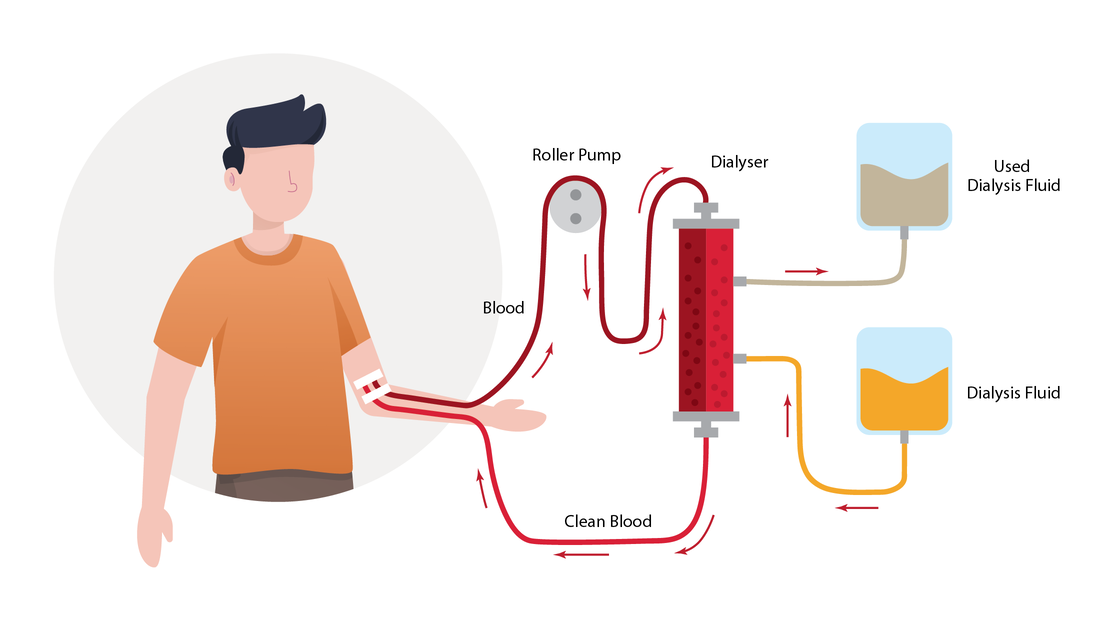
Chạy thận nhân tạo là quá trình lấy máu của bệnh nhân ra khỏi cơ thể, lọc máu và đưa máu trở lại. Máu được đưa qua một máy lọc máu, còn gọi là thận nhân tạo, nơi nó được lọc qua màng bán thấm để loại bỏ chất thải và chất lỏng dư thừa.
Phương pháp này yêu cầu bệnh nhân đến trung tâm chạy thận, thường 2-3 lần mỗi tuần, mỗi lần kéo dài 4-5 giờ. Do chạy thận nhân tạo loại bỏ chất thải và chất lỏng một cách gián đoạn, bệnh nhân phải tuân thủ chế độ ăn nghiêm ngặt, hạn chế kali, phốt pho, muối và chất lỏng, đồng thời đảm bảo lượng protein hợp lý (khoảng 1.0-1.2g/kg). Bệnh nhân tiểu đường cũng có thể cần hạn chế lượng đường tiêu thụ.
[1]
2) Peritoneal Dialysis
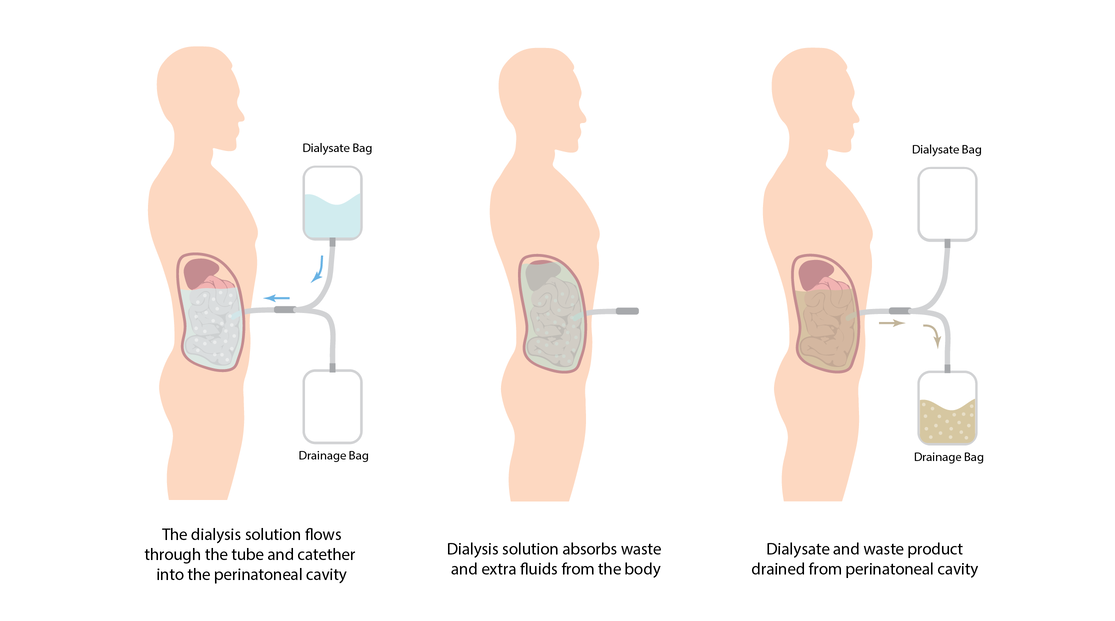
Chạy thận phúc mạc (PD) sử dụng màng bán thấm tự nhiên của phúc mạc để lọc máu trong cơ thể. Một ống thông được phẫu thuật cấy vào khoang bụng, đóng vai trò là kênh dẫn dịch lọc thận. Bệnh nhân sử dụng máy Chạy Thận Phúc Mạc Liên Tục (CAPD) tại nhà. Trong quá trình điều trị, dịch lọc được đưa vào khoang bụng qua ống thông, nơi nó trao đổi chất thải và điện giải với máu qua màng phúc mạc, sau đó dịch được rút ra.
Chạy thận phúc mạc có thể thực hiện tại nhà, bệnh nhân thay dịch lọc 4-5 lần mỗi ngày, mỗi lần kéo dài khoảng 4 giờ. Ngoài ra, còn có Chạy Thận Phúc Mạc Tự Động (APD), hoạt động qua đêm khi bệnh nhân ngủ. Các hạn chế về chế độ ăn uống ít nghiêm ngặt hơn so với chạy thận nhân tạo, nhưng bệnh nhân cần xử lý quy trình cẩn thận và duy trì ống thông để tránh bị lệch hoặc nhiễm trùng.
Chạy thận phúc mạc (PD) sử dụng màng bán thấm tự nhiên của phúc mạc để lọc máu trong cơ thể. Một ống thông được phẫu thuật cấy vào khoang bụng, đóng vai trò là kênh dẫn dịch lọc thận. Bệnh nhân sử dụng máy Chạy Thận Phúc Mạc Liên Tục (CAPD) tại nhà. Trong quá trình điều trị, dịch lọc được đưa vào khoang bụng qua ống thông, nơi nó trao đổi chất thải và điện giải với máu qua màng phúc mạc, sau đó dịch được rút ra.
Chạy thận phúc mạc có thể thực hiện tại nhà, bệnh nhân thay dịch lọc 4-5 lần mỗi ngày, mỗi lần kéo dài khoảng 4 giờ. Ngoài ra, còn có Chạy Thận Phúc Mạc Tự Động (APD), hoạt động qua đêm khi bệnh nhân ngủ. Các hạn chế về chế độ ăn uống ít nghiêm ngặt hơn so với chạy thận nhân tạo, nhưng bệnh nhân cần xử lý quy trình cẩn thận và duy trì ống thông để tránh bị lệch hoặc nhiễm trùng.
[2]
3) Xử lý nước trong thiết bị lọc máu
Trong điều trị chạy thận nhân tạo, dịch lọc máu tiếp xúc trực tiếp với máu của bệnh nhân, khiến chất lượng nước trở nên cực kỳ quan trọng. Các bệnh viện áp dụng các tiêu chuẩn nghiêm ngặt về chất lượng nước để đảm bảo an toàn cho bệnh nhân.
Các hóa chất thường có trong nước máy, như nhôm, chloramines, fluoride, đồng và kẽm, có thể gây rủi ro nghiêm trọng cho bệnh nhân thận nếu không được lọc đúng cách. Hiểu rõ những rủi ro này nhấn mạnh vai trò thiết yếu của xử lý nước trong thiết bị lọc máu, đảm bảo nước sử dụng không chứa các chất gây hại và an toàn cho mục đích y tế.
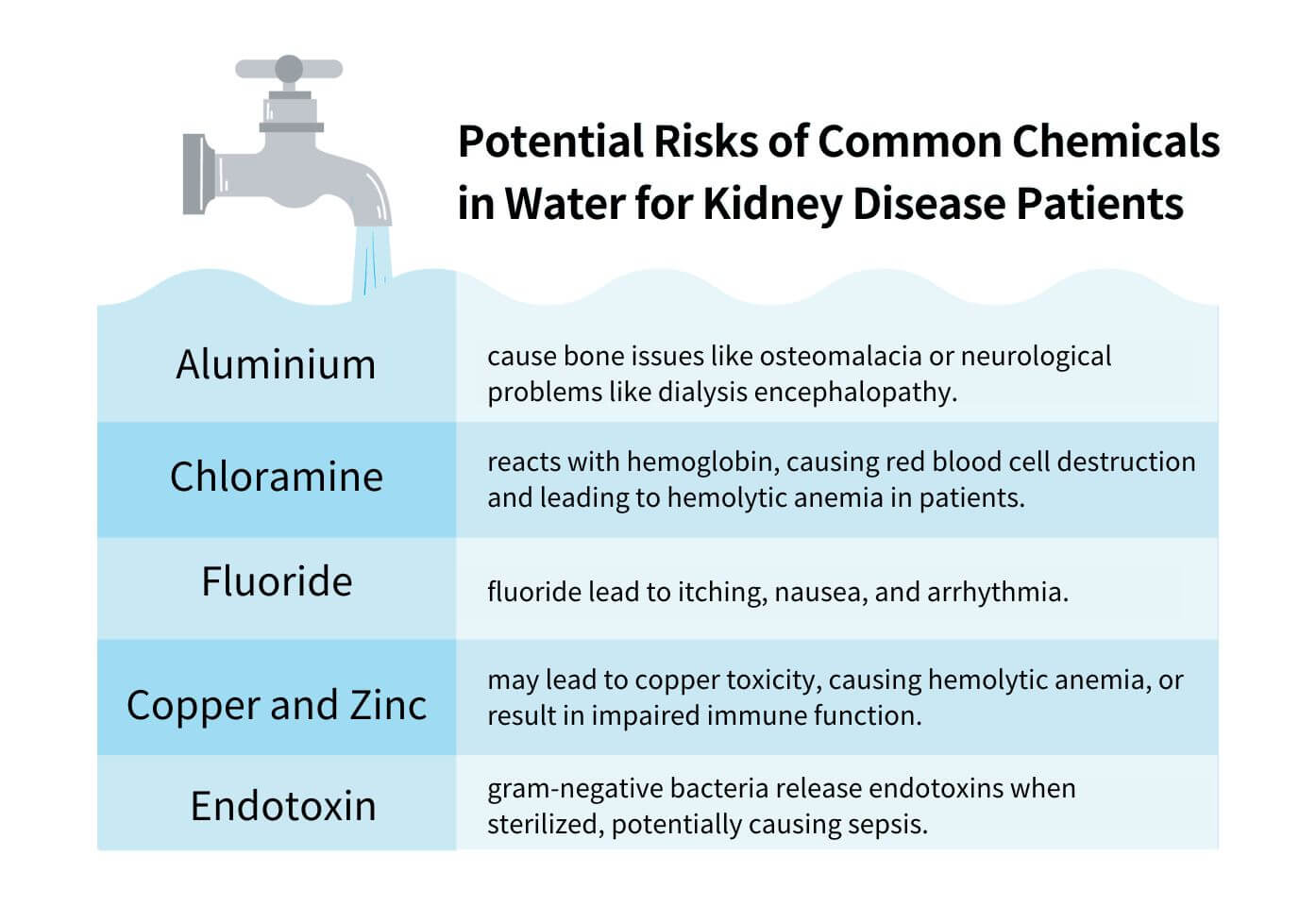
Nhôm
Hệ thống nước máy thường chứa nhôm, được sử dụng như một chất keo tụ để loại bỏ các hạt lơ lửng. Trong khi thận khỏe mạnh có thể lọc nhôm dư thừa, thận bị suy không thể làm điều này, dẫn đến tích tụ nhôm. Điều này có thể gây ra chứng nhuyễn xương, một tình trạng làm mềm xương, và bệnh não do chạy thận, một rối loạn thần kinh.
Chloramine
Chloramine là một chất khử trùng trong nước uống, hiệu quả trong các hệ thống phân phối dài. Tuy nhiên, nếu không được loại bỏ trong quá trình chạy thận, chloramine có thể đi qua màng lọc thận vào máu, phản ứng với hemoglobin và gây thiếu máu tan huyết.
Fluoride
Fluoride, được biết đến với tác dụng làm chắc men răng, được thêm vào nước uống vì lợi ích nha khoa. Tuy nhiên, đối với bệnh nhân suy thận, fluoride dư thừa không thể được lọc hiệu quả, dẫn đến các triệu chứng như ngứa, buồn nôn và loạn nhịp tim.
Đồng và Kẽm
Đồng và kẽm có thể rò rỉ từ ống nước và phụ kiện vào nguồn nước. Trong khi thận khỏe mạnh có thể điều tiết các kim loại này, thận bị suy có thể dẫn đến ngộ độc đồng, thiếu máu tan huyết hoặc suy giảm chức năng miễn dịch.
Endotoxin
Nước máy có thể chứa vi sinh vật, bao gồm vi khuẩn gram âm. Trong khi chloramine trong hệ thống cấp nước đô thị giết chết vi khuẩn, thành tế bào chết của vi khuẩn có thể giải phóng endotoxin. Thông thường, gan và hệ miễn dịch xử lý endotoxin, nhưng nếu không được lọc trong quá trình chạy thận, chúng có thể gây nhiễm trùng huyết.
4. Nước siêu tinh khiết là gì? Nó được tạo ra như thế nào?
Nhận thức về rủi ro từ các chất thường gặp trong nước máy đối với bệnh nhân suy thận nhấn mạnh tầm quan trọng của xử lý nước trong chạy thận nhân tạo. Để giảm thiểu những rủi ro này, các trung tâm chạy thận sản xuất "dịch lọc siêu tinh khiết" theo tiêu chuẩn nghiêm ngặt về độ tinh khiết nước do Hiệp hội Tiến bộ Thiết bị Y tế (AAMI) và Tổ chức Tiêu chuẩn hóa Quốc tế (ISO) đặt ra.
Các tiêu chuẩn này quy định rằng lượng vi khuẩn trong nước phải dưới 100 CFU/mL và mức endotoxin phải dưới 0.25 EU/mL. Nước siêu tinh khiết này rất cần thiết để làm sạch máu bệnh nhân một cách an toàn trong quá trình lọc máu, giảm thiểu nguy cơ đưa các chất gây hại vào cơ thể.
[3]
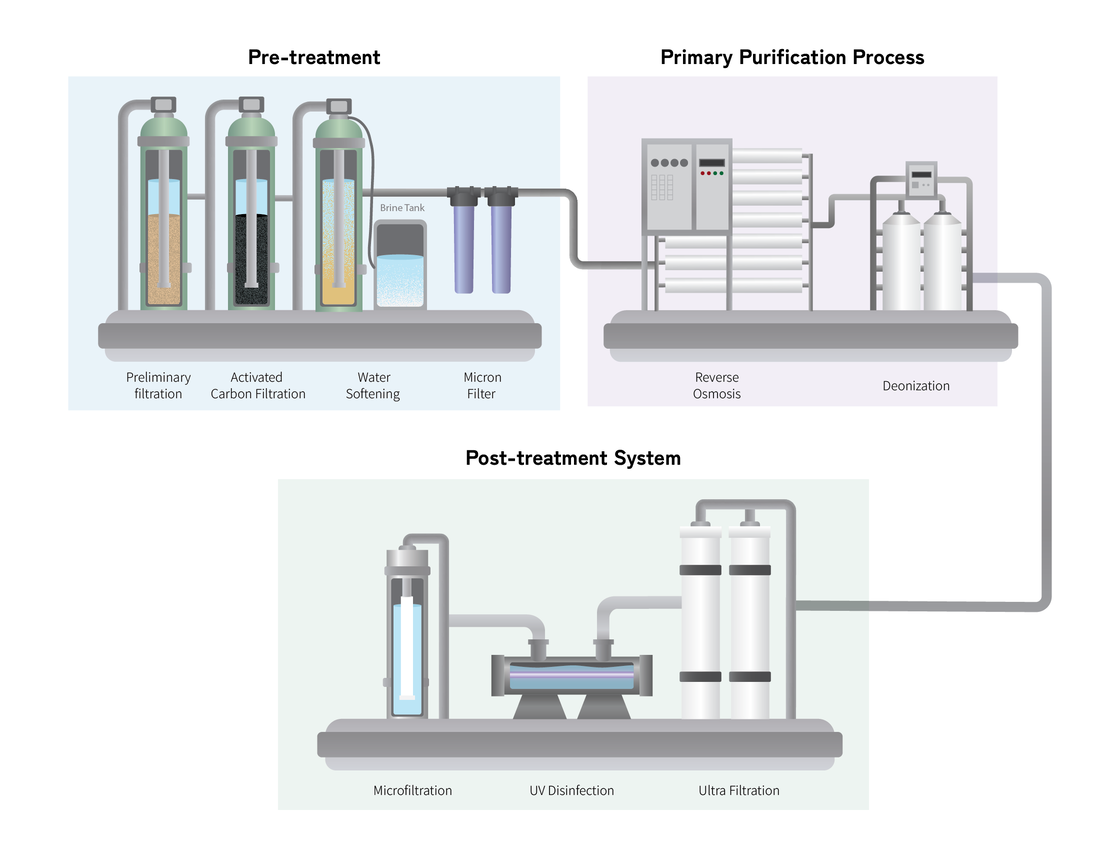
1) Xử lý sơ bộ
Mục tiêu chính của xử lý sơ bộ là loại bỏ tạp chất và bảo vệ hệ thống xử lý chính.
1. Lọc sơ bộ (Preliminary Filtration): Loại bỏ các hạt lớn, trầm tích và chất rắn lơ lửng.
2. Lọc than hoạt tính (Activated Carbon Filtration): Nước được lọc qua lớp than hoạt tính dạng hạt (GAC) để hấp thụ các chất hữu cơ, clo dư và chloramines.
3. Làm mềm nước (Water Softening): Sử dụng nhựa trao đổi ion để làm mềm nước bằng cách thay thế ion canxi và magiê bằng ion natri, ngăn chặn hình thành cặn.
4. Lọc vi lọc (Micron Filters): Loại bỏ tạp chất có kích thước nhỏ đến 1 micron.
2) Quy trình tinh lọc chính
Giai đoạn này tập trung vào việc làm sạch nước ở mức độ cao.
5. Thẩm thấu ngược (Reverse Osmosis, RO): Sử dụng áp suất thẩm thấu để đẩy nước qua màng bán thấm, loại bỏ hơn 90% tạp chất, bao gồm muối hòa tan, ion kim loại, vi khuẩn và endotoxins.
6. Khử ion (Deionization, DI): Sử dụng nhựa trao đổi ion dạng hỗn hợp để loại bỏ các cation và anion còn lại, giúp loại bỏ hoàn toàn các chất gây ô nhiễm ion.
3) Hệ thống xử lý sau
Giai đoạn này nhấn mạnh việc tiệt trùng và lọc để đảm bảo độ tinh khiết của nước.
7. Siêu Lọc (Ultrafiltration, UF) - Loại bỏ vi khuẩn có thể phát triển trong quá trình DI do môi trường ẩm ướt.
8. Khử Trùng Bằng Tia Cực Tím (Ultraviolet Disinfection, UV) - Sử dụng tia UV-C để phá hủy DNA và RNA của vi sinh vật, tiệt trùng nước một cách hiệu quả.
9. Lọc Vi Sinh (Microfiltration) - Giai đoạn cuối cùng sử dụng bộ lọc 0.2 micron để đảm bảo độ tinh khiết cao nhất của nước, phù hợp cho việc sử dụng trong chạy thận.
[4][5][6]
5. Lưu lượng kế siêu âm và thu thập dữ liệu tự động
Trong chuyến thăm công ty Lee Med Tech Co., Ltd. tại Nam Phong, Thái Lan, chúng tôi đã tìm hiểu cách các đồng hồ đo lưu lượng siêu âm và cảm biến khác tự động hóa việc thu thập và truyền dữ liệu trong hệ thống xử lý nước. Lee Med Tech Co., Ltd. cung cấp thiết bị xử lý nước và dịch vụ dữ liệu đám mây cho trung tâm chạy thận nhân tạo của Bệnh viện Fort Kawila.
Dữ liệu được thu thập được truyền đến một nền tảng đám mây để phân tích và bảo trì theo thời gian thực, nâng cao độ tin cậy và an toàn cho các quy trình xử lý nước. Để biết thêm chi tiết về vai trò của cảm biến trong công nghệ y tế và hệ thống nước siêu tinh khiết, hãy đọc bài viết "Cảm Biến Trong Công Nghệ Y Tế Và Hệ Thống Nước Siêu Tinh Khiết."
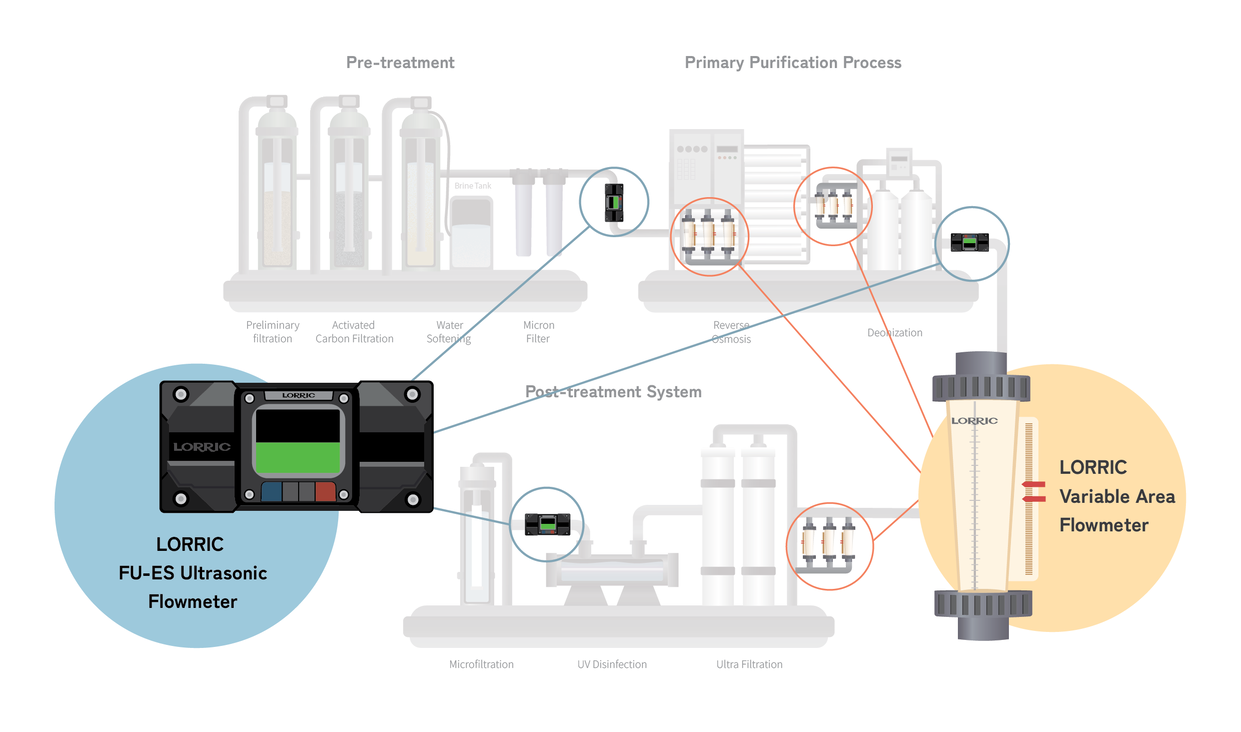
Tại hiện trường, chúng tôi đã lắp đặt lưu lượng kế siêu âm LORRIC FU-ES trên đường ống của thiết bị thẩm thấu ngược (RO).
Các lưu lượng kế này được trang bị giao thức truyền thông RS485, cho phép truyền thông tin lưu lượng phát hiện được đến Bộ điều khiển logic lập trình (PLC). PLC xử lý các tín hiệu đầu vào dựa trên các hướng dẫn điều khiển đã được lập trình trước, giám sát và tự động hóa các hệ thống cơ khí và điện.
Dữ liệu được thu thập bởi PLC được truyền qua giao thức MQTT sử dụng TCP/IP đến một mạng đám mây được chỉ định.
Thiết lập này cho phép bệnh viện thu thập và tổ chức dữ liệu về lượng nước sử dụng cho chạy thận. Bằng cách đăng nhập vào cơ sở dữ liệu đám mây, nhân viên có thể truy cập dữ liệu tiêu thụ nước theo thời gian thực và các thông tin liên quan từ bất kỳ máy tính hoặc thiết bị di động nào, giúp việc giám sát và quản lý trở nên hiệu quả hơn.
[7][8]

Tại Sao Nên Chọn "Đồng Hồ Đo Lưu Lượng Siêu Âm LORRIC FU-ES"?
Lắp Đặt Không Xâm Lấn: Đồng hồ đo lưu lượng siêu âm FU-ES có thiết kế kẹp ngoài, cho phép lắp đặt mà không cần cắt ống hoặc dừng hệ thống. Điều này đảm bảo thiết bị có thể được lắp đặt mà không làm gián đoạn hoạt động.
Hỗ Trợ Nhiều Giao Thức Truyền Thông: FU-ES hỗ trợ nhiều giao thức truyền thông, mang lại sự linh hoạt tùy theo nhu cầu cụ thể. Các tùy chọn bao gồm đầu ra analog 16-bit 4-20mA, Modbus RTU RS485 và tín hiệu công tắc cặp quang hai dây (tương thích với NPN/PNP).
Công Nghệ EchoSense: Công nghệ phần mềm tiên tiến này tự động phát hiện dữ liệu như đường kính ống, thông số kỹ thuật ống và môi trường đo. Đồng hồ có thể hoạt động ngay sau khi lắp đặt mà không cần thiết lập các thông số phức tạp. Trong chuyến thăm công ty Lee Med Tech, FU-ES đã được lắp đặt thành công trên các ống PVC, thép không gỉ 316 và PVDF, chứng minh hiệu suất đáng tin cậy trên nhiều loại vật liệu khác nhau.
Với sự hỗ trợ giao thức truyền thông đa dạng và thiết kế dễ lắp đặt của FU-ES, LORRIC đã giúp các nhà sản xuất thiết bị đạt được việc thu thập dữ liệu lưu lượng tự động, cung cấp cơ sở dữ liệu đám mây cho các trung tâm chạy thận. Chúng tôi mong đợi sự hỗ trợ liên tục của thương hiệu trong việc thúc đẩy các ứng dụng trong ngành thiết bị và y tế.
Tìm hiểu thêm tại: Đồng Hồ Đo Lưu Lượng Siêu Âm LORRIC FU-ES